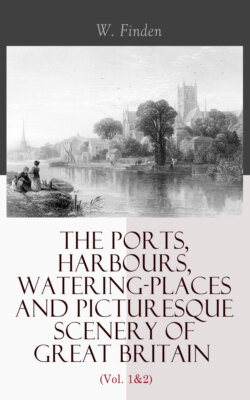Читать книгу The Ports, Harbours, Watering-places and Picturesque Scenery of Great Britain (Vol. 1&2) - W. Finden - Страница 19
На сайте Литреса книга снята с продажи.
HARTLEPOOL.
ОглавлениеTable of Contents
The view of Hartlepool, painted by T. Creswick, from a drawing by G. Balmer, is taken from the northward. To the right, between the foreground and the town, are seen the sands of what is called the "Slake;" to the left are the cliffs, at the foot of which are the excavations called "Fairy Coves;" and beyond the town part of the southern coast of Durham is perceived, which extends from Hartlepool southward to the mouth of the Tees. The figures in the foreground are characteristic of the place; for there is no obtaining a view of Hartlepool from the land-side without seeing a group of fishwomen.
The town of Hartlepool stands on a small peninsula on the southern coast of Durham, and is about nine miles north-east of Stockton-upon-Tees. From the "Slake," or Pool, which is between the town and the mainland to the west, it probably received the appellation of "Le Poole," to distinguish it from the village of Hart, which is about four miles and a half to the north-west. The word Hart, according to Ducange, signified, in Teutonic, a forest; and, if the name of the parish of Hart be of the same origin, the reason why the place should have been so called is obvious. The old town-seal of Hartlepool contains a rebus of the name—a hart up to his knees in a pool—which assigns to the first part of it a different etymology. Previous to receiving the name of Hartlepool the place was called Heortu, and sometimes Heortness; the terminating u is perhaps an abbreviation of eau, water; and the name Heortu synonymous with Hart-le-pool. The termination ness is expressive of the place being built on a point of land which projects into the sea. "At or near this place," says Bishop Tanner, in the Notitia Monastica, "was the ancient monastery called Heorthu, founded upon the first conversion of the Northumbrians to Christianity, about A.D. 640, by a religious woman named Hieu, or, as some have it, St. Bega, whereof St. Hilda was some time abbess." This ancient convent was destroyed by the Danes about 800, and its site is now unknown, though it is supposed to have stood on the spot which was subsequently occupied by a Franciscan monastery, founded by one of the Bruce family about 1250, and suppressed by Henry VIII. Of this monastery or its church there is at present no part remaining, though some old houses, called the Friary, probably built out of the ruins, still indicate its situation. The church of Hartlepool, which is dedicated to St. Hilda, is a large building, and, from the various styles of its architecture, has evidently been built at different periods.
About the time of the Conquest, the manors of Hart and Hartness belonged to Fulk de Panell; and, upon the marriage of his daughter Agnes with Robert de Brus, one of the Norman followers of William I., they came, with other rich manors in Yorkshire and in Durham, into the possession of that family. Upon Robert Bruce, a descendant of the above-named Robert de Brus, succeeding to the crown of Scotland in 1306, all his English estates were confiscated by Edward I., who granted the manor of Hart and the borough of Hartlepool to Robert de Clifford, "saving the rights of the Bishops of Durham," under whom, since 1189, the property had been held.
In 1201, King John granted a charter to Hartlepool, conferring upon the burgesses the same privileges as those of Newcastle-upon-Tyne; and in 1230, Richard le Poor, Bishop of Durham, granted another charter, appointing a mayor and other officers for the government of the town. In 1593, Queen Elizabeth granted a new charter, under which the affairs of the borough have been since regulated.
From the reign of King John to that of James I., Hartlepool was the most considerable port in the county of Durham; but from the latter period till about seven years ago, its importance as a place of trade appears to have greatly declined: and from 1730 to 1832, its condition was that of a small fishing town, scarcely visited by any ships, except colliers belonging to Sunderland and Newcastle, which occasionally sought refuge in its harbour during a storm. In 1832, a bill was obtained for the purpose of improving the harbour and forming a dock at Hartlepool; and since that period a considerable portion of the projected works have been finished. A railway has since been formed, by which coals are brought to the town; and a considerable quantity are now shipped there for the London and other markets; and from the advantageous situation of the harbour, and the facility with which vessels can be loaded, there seems great probability of Hartlepool becoming, in a few years, one of the principal ports for the shipment of coals in the county of Durham.
SUNDERLAND. THE LIGHT HOUSE ON THE SOUTH PIER.
